Supply Chain Management Report: IKEA Case Study Analysis, Logistics
VerifiedAdded on 2020/03/16
|13
|2536
|111
Report
AI Summary
This report delves into the multifaceted world of logistics and supply chain management, encompassing a range of critical topics. It begins with an exploration of forecasting, highlighting its significance in aligning supply with demand, and the different types of forecasting methods. The report then examines the role of Third-Party Logistics (3PLs) in outsourcing logistics services, followed by an analysis of humanitarian logistics and the organizational structures involved in disaster relief. Furthermore, the report explores the application of Information Technology (IT) in optimizing supply chains. The second section presents case studies, specifically focusing on IKEA's sustainable supply chain practices, including its sourcing strategies, environmental impact assessments, and customer engagement methods. The report analyzes the effects of IKEA's practices on the furniture industry and describes how IKEA uses its customers to enhance efficiency and effectiveness. Finally, the report discusses IKEA's collaborative approach with suppliers to ensure end-customer satisfaction.
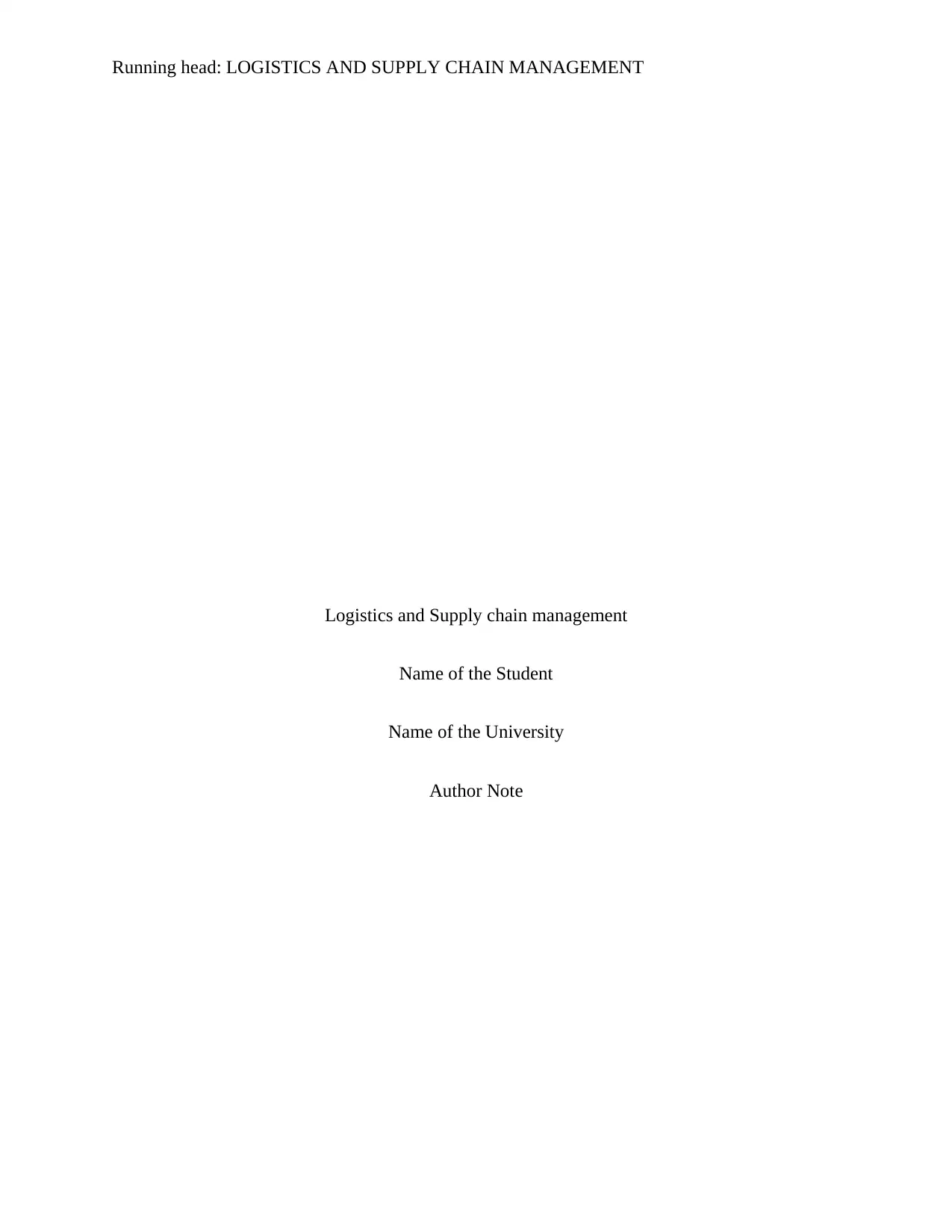
Running head: LOGISTICS AND SUPPLY CHAIN MANAGEMENT
Logistics and Supply chain management
Name of the Student
Name of the University
Author Note
Logistics and Supply chain management
Name of the Student
Name of the University
Author Note
Paraphrase This Document
Need a fresh take? Get an instant paraphrase of this document with our AI Paraphraser
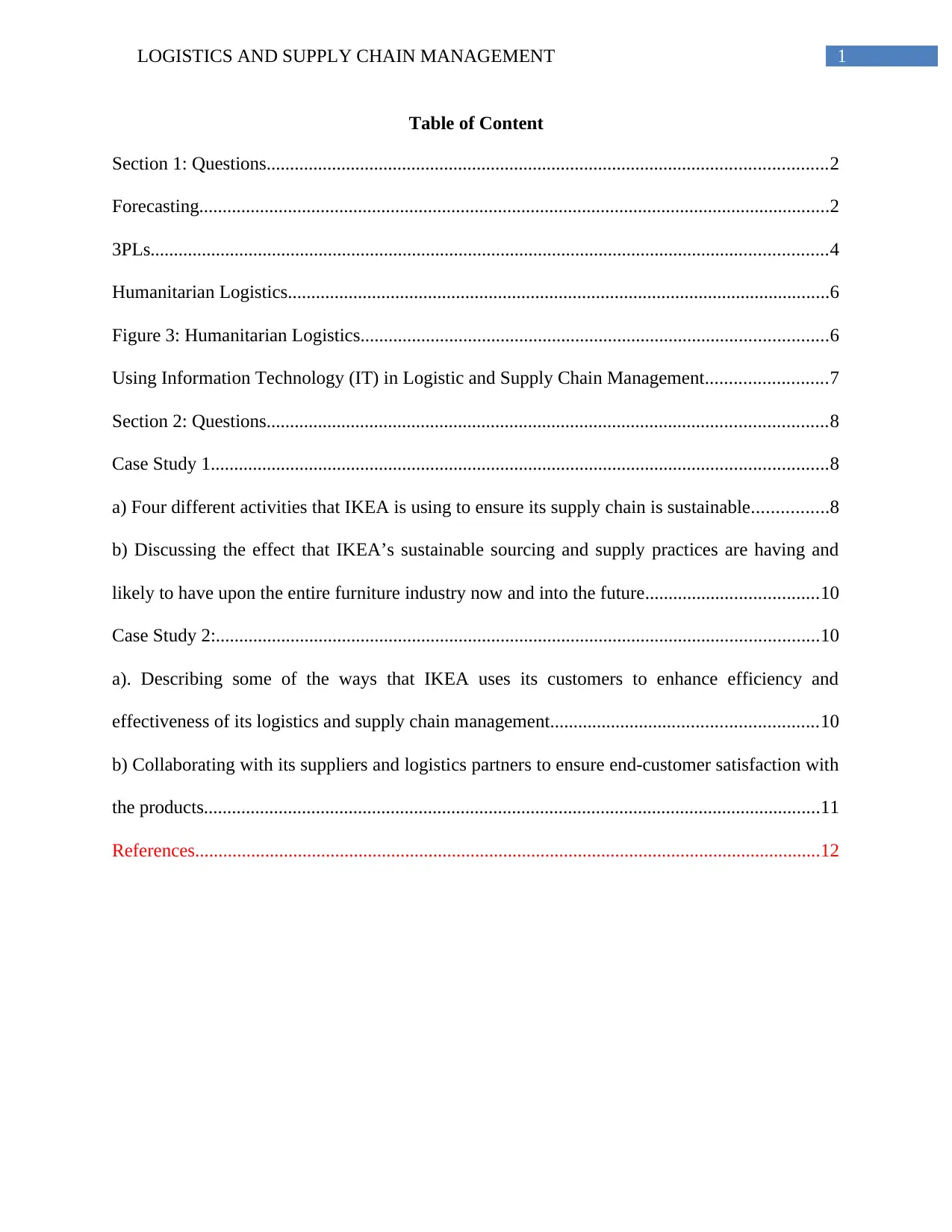
1LOGISTICS AND SUPPLY CHAIN MANAGEMENT
Table of Content
Section 1: Questions........................................................................................................................2
Forecasting.......................................................................................................................................2
3PLs.................................................................................................................................................4
Humanitarian Logistics....................................................................................................................6
Figure 3: Humanitarian Logistics....................................................................................................6
Using Information Technology (IT) in Logistic and Supply Chain Management..........................7
Section 2: Questions........................................................................................................................8
Case Study 1....................................................................................................................................8
a) Four different activities that IKEA is using to ensure its supply chain is sustainable................8
b) Discussing the effect that IKEA’s sustainable sourcing and supply practices are having and
likely to have upon the entire furniture industry now and into the future.....................................10
Case Study 2:.................................................................................................................................10
a). Describing some of the ways that IKEA uses its customers to enhance efficiency and
effectiveness of its logistics and supply chain management.........................................................10
b) Collaborating with its suppliers and logistics partners to ensure end-customer satisfaction with
the products....................................................................................................................................11
References......................................................................................................................................12
Table of Content
Section 1: Questions........................................................................................................................2
Forecasting.......................................................................................................................................2
3PLs.................................................................................................................................................4
Humanitarian Logistics....................................................................................................................6
Figure 3: Humanitarian Logistics....................................................................................................6
Using Information Technology (IT) in Logistic and Supply Chain Management..........................7
Section 2: Questions........................................................................................................................8
Case Study 1....................................................................................................................................8
a) Four different activities that IKEA is using to ensure its supply chain is sustainable................8
b) Discussing the effect that IKEA’s sustainable sourcing and supply practices are having and
likely to have upon the entire furniture industry now and into the future.....................................10
Case Study 2:.................................................................................................................................10
a). Describing some of the ways that IKEA uses its customers to enhance efficiency and
effectiveness of its logistics and supply chain management.........................................................10
b) Collaborating with its suppliers and logistics partners to ensure end-customer satisfaction with
the products....................................................................................................................................11
References......................................................................................................................................12
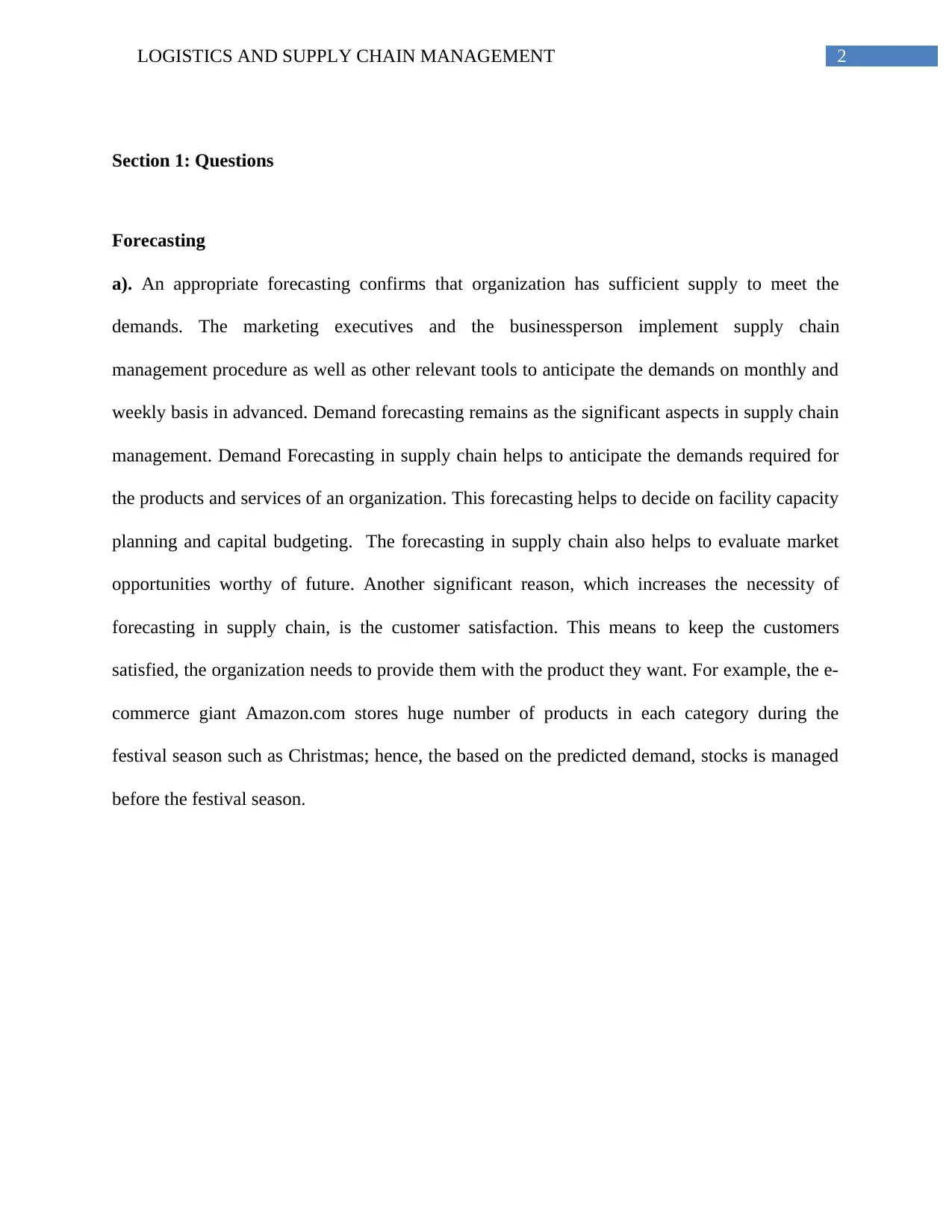
2LOGISTICS AND SUPPLY CHAIN MANAGEMENT
Section 1: Questions
Forecasting
a). An appropriate forecasting confirms that organization has sufficient supply to meet the
demands. The marketing executives and the businessperson implement supply chain
management procedure as well as other relevant tools to anticipate the demands on monthly and
weekly basis in advanced. Demand forecasting remains as the significant aspects in supply chain
management. Demand Forecasting in supply chain helps to anticipate the demands required for
the products and services of an organization. This forecasting helps to decide on facility capacity
planning and capital budgeting. The forecasting in supply chain also helps to evaluate market
opportunities worthy of future. Another significant reason, which increases the necessity of
forecasting in supply chain, is the customer satisfaction. This means to keep the customers
satisfied, the organization needs to provide them with the product they want. For example, the e-
commerce giant Amazon.com stores huge number of products in each category during the
festival season such as Christmas; hence, the based on the predicted demand, stocks is managed
before the festival season.
Section 1: Questions
Forecasting
a). An appropriate forecasting confirms that organization has sufficient supply to meet the
demands. The marketing executives and the businessperson implement supply chain
management procedure as well as other relevant tools to anticipate the demands on monthly and
weekly basis in advanced. Demand forecasting remains as the significant aspects in supply chain
management. Demand Forecasting in supply chain helps to anticipate the demands required for
the products and services of an organization. This forecasting helps to decide on facility capacity
planning and capital budgeting. The forecasting in supply chain also helps to evaluate market
opportunities worthy of future. Another significant reason, which increases the necessity of
forecasting in supply chain, is the customer satisfaction. This means to keep the customers
satisfied, the organization needs to provide them with the product they want. For example, the e-
commerce giant Amazon.com stores huge number of products in each category during the
festival season such as Christmas; hence, the based on the predicted demand, stocks is managed
before the festival season.
⊘ This is a preview!⊘
Do you want full access?
Subscribe today to unlock all pages.

Trusted by 1+ million students worldwide
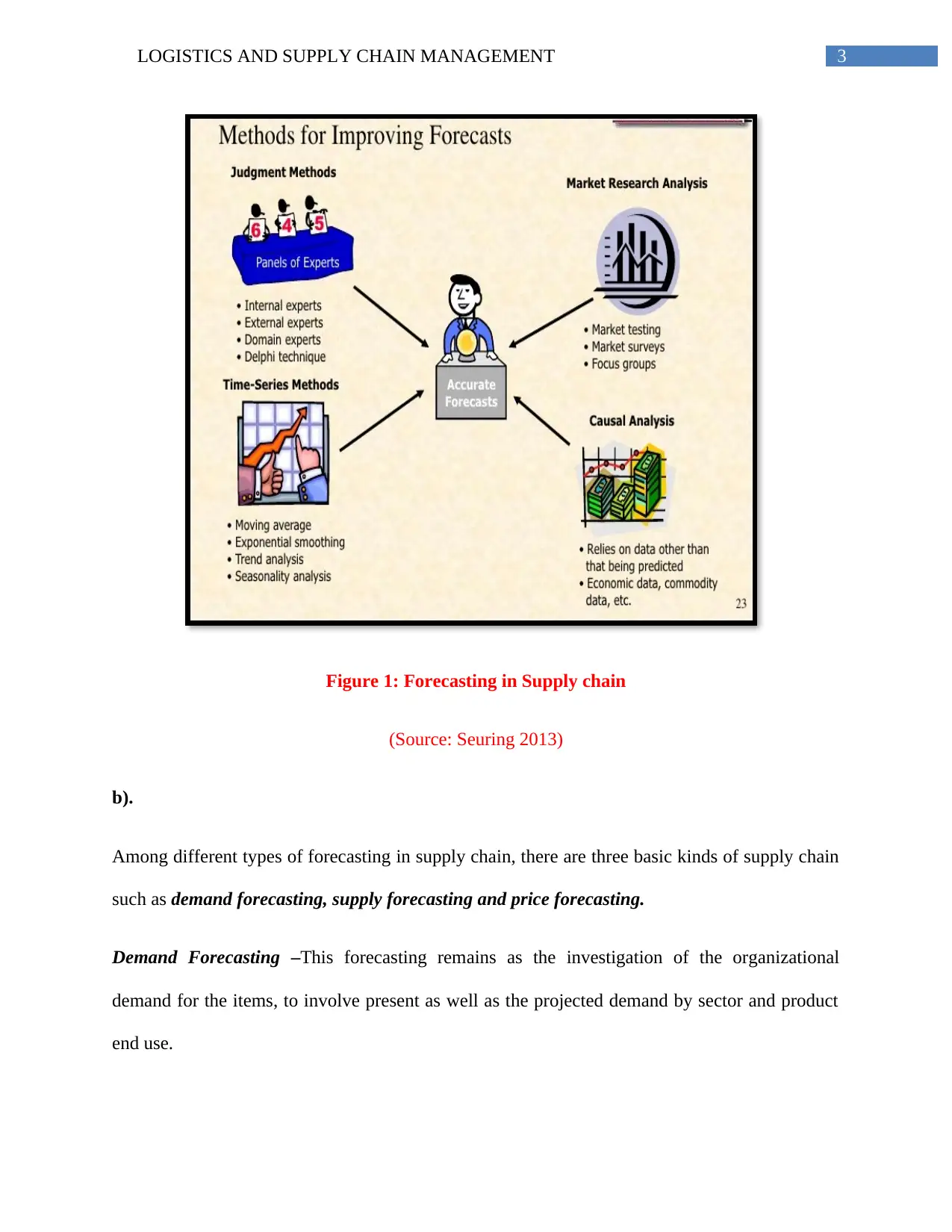
3LOGISTICS AND SUPPLY CHAIN MANAGEMENT
Figure 1: Forecasting in Supply chain
(Source: Seuring 2013)
b).
Among different types of forecasting in supply chain, there are three basic kinds of supply chain
such as demand forecasting, supply forecasting and price forecasting.
Demand Forecasting –This forecasting remains as the investigation of the organizational
demand for the items, to involve present as well as the projected demand by sector and product
end use.
Figure 1: Forecasting in Supply chain
(Source: Seuring 2013)
b).
Among different types of forecasting in supply chain, there are three basic kinds of supply chain
such as demand forecasting, supply forecasting and price forecasting.
Demand Forecasting –This forecasting remains as the investigation of the organizational
demand for the items, to involve present as well as the projected demand by sector and product
end use.
Paraphrase This Document
Need a fresh take? Get an instant paraphrase of this document with our AI Paraphraser
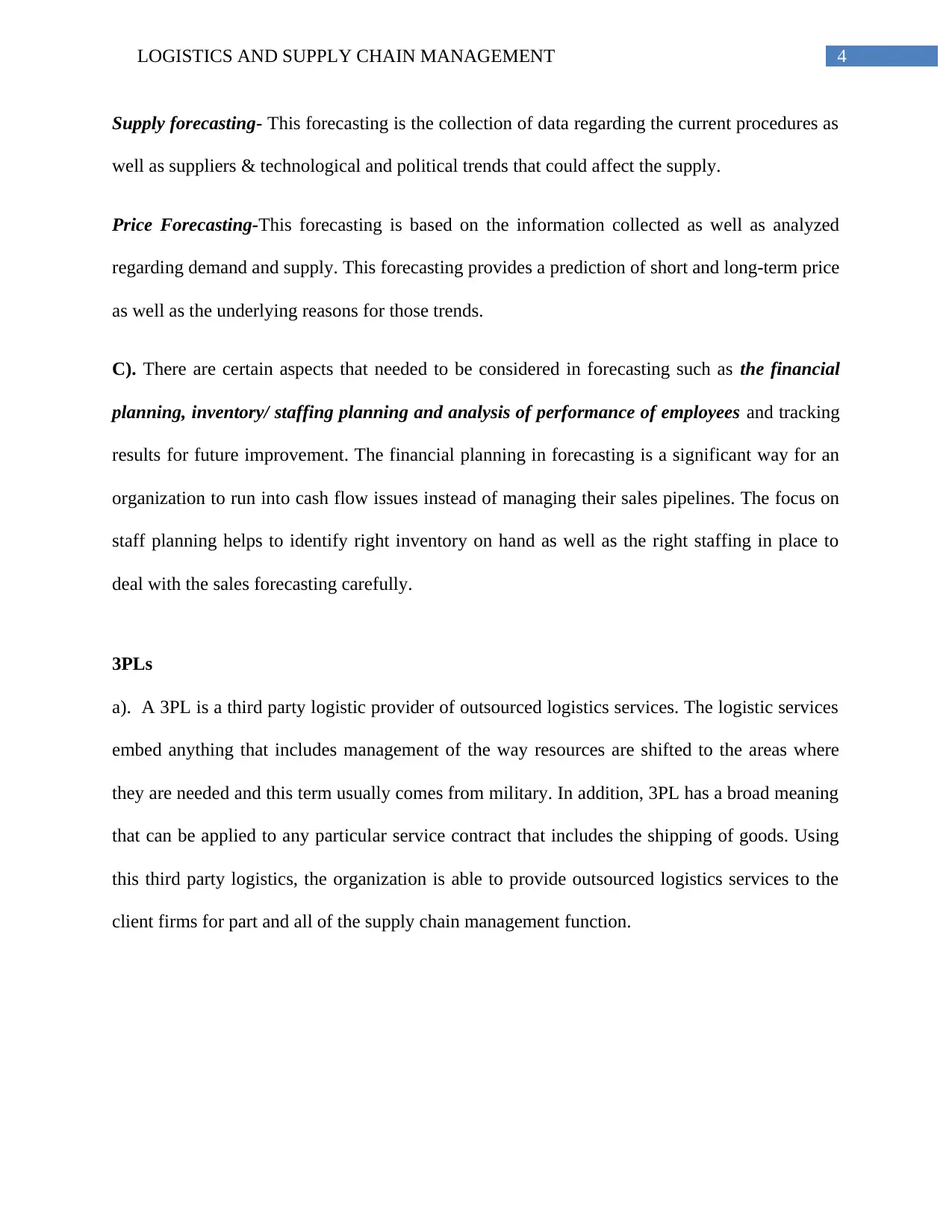
4LOGISTICS AND SUPPLY CHAIN MANAGEMENT
Supply forecasting- This forecasting is the collection of data regarding the current procedures as
well as suppliers & technological and political trends that could affect the supply.
Price Forecasting-This forecasting is based on the information collected as well as analyzed
regarding demand and supply. This forecasting provides a prediction of short and long-term price
as well as the underlying reasons for those trends.
C). There are certain aspects that needed to be considered in forecasting such as the financial
planning, inventory/ staffing planning and analysis of performance of employees and tracking
results for future improvement. The financial planning in forecasting is a significant way for an
organization to run into cash flow issues instead of managing their sales pipelines. The focus on
staff planning helps to identify right inventory on hand as well as the right staffing in place to
deal with the sales forecasting carefully.
3PLs
a). A 3PL is a third party logistic provider of outsourced logistics services. The logistic services
embed anything that includes management of the way resources are shifted to the areas where
they are needed and this term usually comes from military. In addition, 3PL has a broad meaning
that can be applied to any particular service contract that includes the shipping of goods. Using
this third party logistics, the organization is able to provide outsourced logistics services to the
client firms for part and all of the supply chain management function.
Supply forecasting- This forecasting is the collection of data regarding the current procedures as
well as suppliers & technological and political trends that could affect the supply.
Price Forecasting-This forecasting is based on the information collected as well as analyzed
regarding demand and supply. This forecasting provides a prediction of short and long-term price
as well as the underlying reasons for those trends.
C). There are certain aspects that needed to be considered in forecasting such as the financial
planning, inventory/ staffing planning and analysis of performance of employees and tracking
results for future improvement. The financial planning in forecasting is a significant way for an
organization to run into cash flow issues instead of managing their sales pipelines. The focus on
staff planning helps to identify right inventory on hand as well as the right staffing in place to
deal with the sales forecasting carefully.
3PLs
a). A 3PL is a third party logistic provider of outsourced logistics services. The logistic services
embed anything that includes management of the way resources are shifted to the areas where
they are needed and this term usually comes from military. In addition, 3PL has a broad meaning
that can be applied to any particular service contract that includes the shipping of goods. Using
this third party logistics, the organization is able to provide outsourced logistics services to the
client firms for part and all of the supply chain management function.
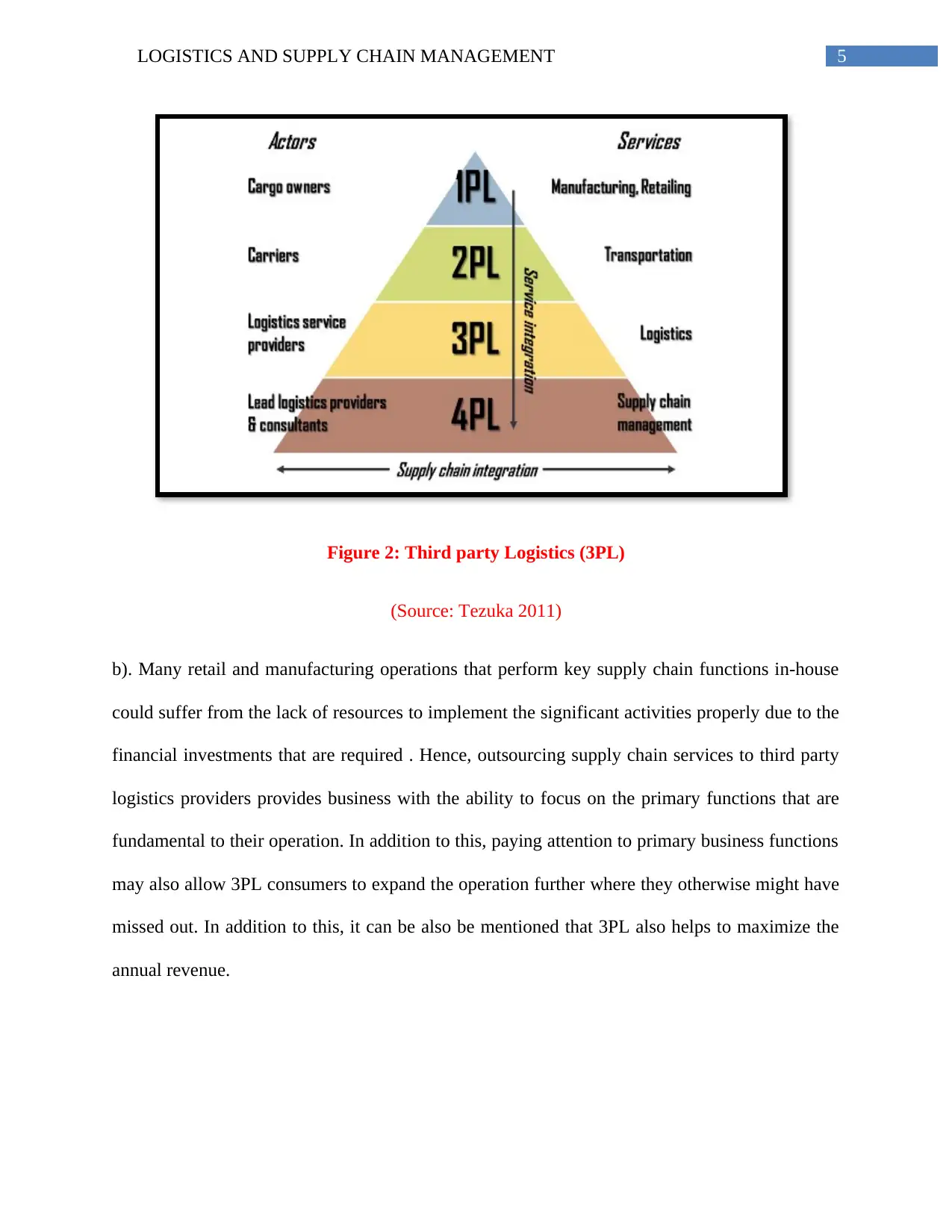
5LOGISTICS AND SUPPLY CHAIN MANAGEMENT
Figure 2: Third party Logistics (3PL)
(Source: Tezuka 2011)
b). Many retail and manufacturing operations that perform key supply chain functions in-house
could suffer from the lack of resources to implement the significant activities properly due to the
financial investments that are required . Hence, outsourcing supply chain services to third party
logistics providers provides business with the ability to focus on the primary functions that are
fundamental to their operation. In addition to this, paying attention to primary business functions
may also allow 3PL consumers to expand the operation further where they otherwise might have
missed out. In addition to this, it can be also be mentioned that 3PL also helps to maximize the
annual revenue.
Figure 2: Third party Logistics (3PL)
(Source: Tezuka 2011)
b). Many retail and manufacturing operations that perform key supply chain functions in-house
could suffer from the lack of resources to implement the significant activities properly due to the
financial investments that are required . Hence, outsourcing supply chain services to third party
logistics providers provides business with the ability to focus on the primary functions that are
fundamental to their operation. In addition to this, paying attention to primary business functions
may also allow 3PL consumers to expand the operation further where they otherwise might have
missed out. In addition to this, it can be also be mentioned that 3PL also helps to maximize the
annual revenue.
⊘ This is a preview!⊘
Do you want full access?
Subscribe today to unlock all pages.

Trusted by 1+ million students worldwide
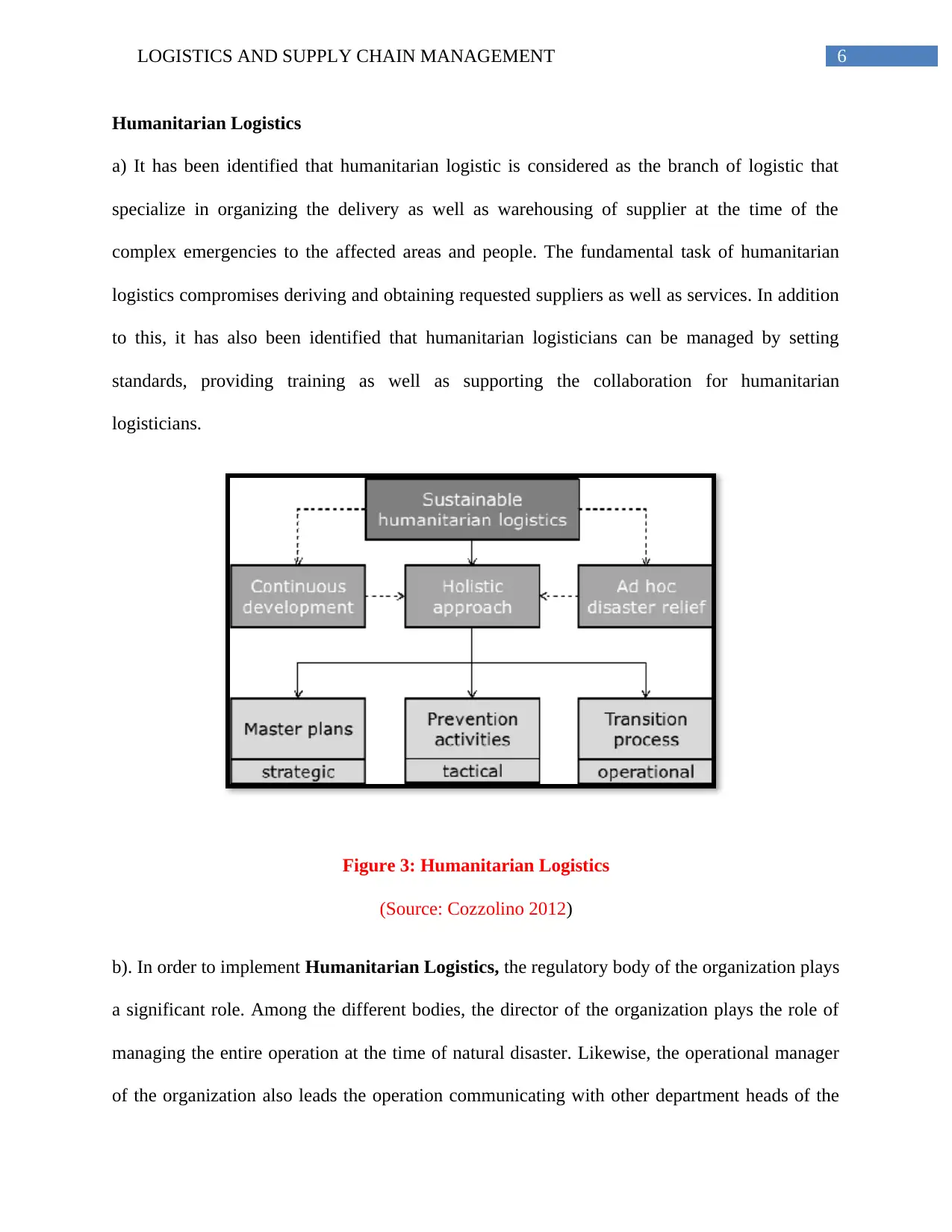
6LOGISTICS AND SUPPLY CHAIN MANAGEMENT
Humanitarian Logistics
a) It has been identified that humanitarian logistic is considered as the branch of logistic that
specialize in organizing the delivery as well as warehousing of supplier at the time of the
complex emergencies to the affected areas and people. The fundamental task of humanitarian
logistics compromises deriving and obtaining requested suppliers as well as services. In addition
to this, it has also been identified that humanitarian logisticians can be managed by setting
standards, providing training as well as supporting the collaboration for humanitarian
logisticians.
Figure 3: Humanitarian Logistics
(Source: Cozzolino 2012)
b). In order to implement Humanitarian Logistics, the regulatory body of the organization plays
a significant role. Among the different bodies, the director of the organization plays the role of
managing the entire operation at the time of natural disaster. Likewise, the operational manager
of the organization also leads the operation communicating with other department heads of the
Humanitarian Logistics
a) It has been identified that humanitarian logistic is considered as the branch of logistic that
specialize in organizing the delivery as well as warehousing of supplier at the time of the
complex emergencies to the affected areas and people. The fundamental task of humanitarian
logistics compromises deriving and obtaining requested suppliers as well as services. In addition
to this, it has also been identified that humanitarian logisticians can be managed by setting
standards, providing training as well as supporting the collaboration for humanitarian
logisticians.
Figure 3: Humanitarian Logistics
(Source: Cozzolino 2012)
b). In order to implement Humanitarian Logistics, the regulatory body of the organization plays
a significant role. Among the different bodies, the director of the organization plays the role of
managing the entire operation at the time of natural disaster. Likewise, the operational manager
of the organization also leads the operation communicating with other department heads of the
Paraphrase This Document
Need a fresh take? Get an instant paraphrase of this document with our AI Paraphraser
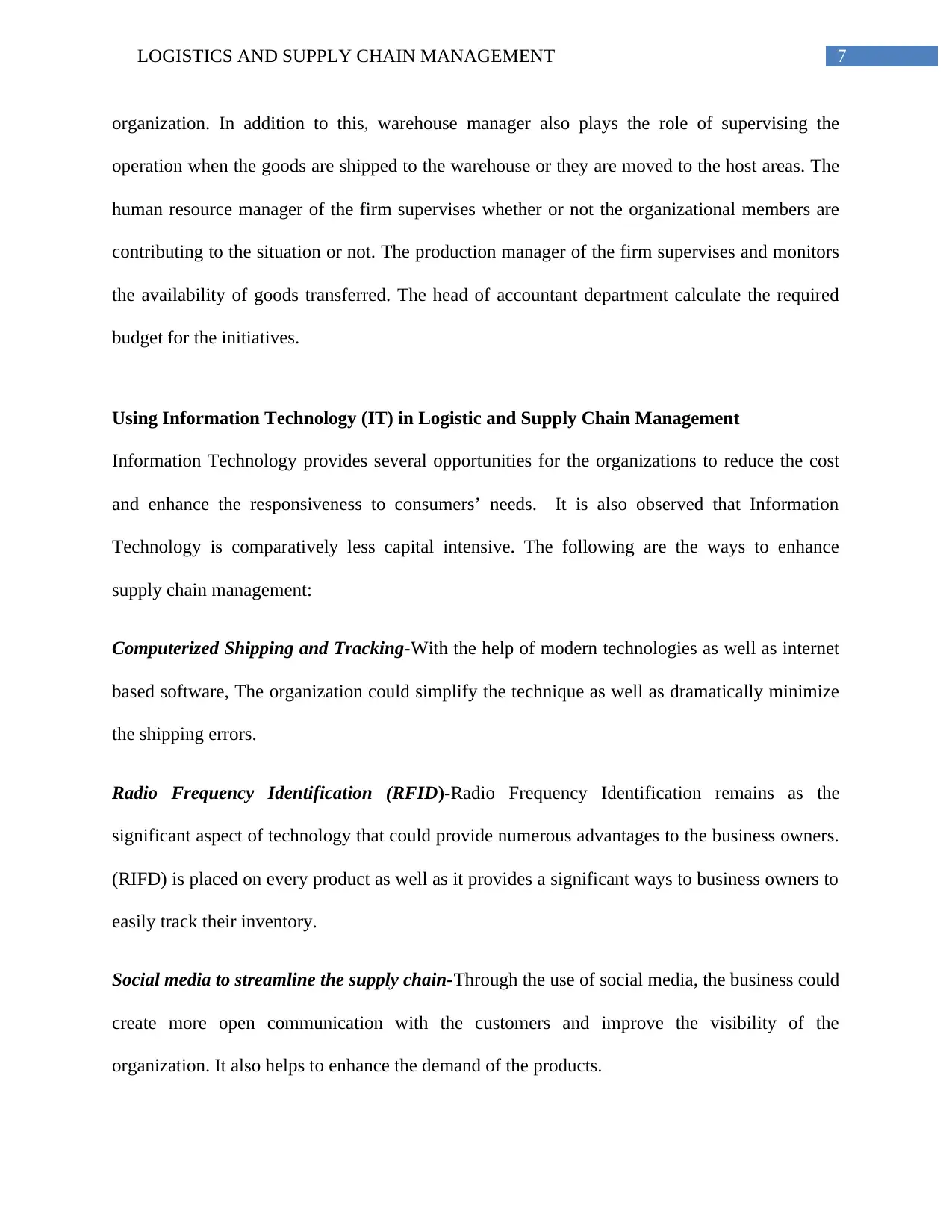
7LOGISTICS AND SUPPLY CHAIN MANAGEMENT
organization. In addition to this, warehouse manager also plays the role of supervising the
operation when the goods are shipped to the warehouse or they are moved to the host areas. The
human resource manager of the firm supervises whether or not the organizational members are
contributing to the situation or not. The production manager of the firm supervises and monitors
the availability of goods transferred. The head of accountant department calculate the required
budget for the initiatives.
Using Information Technology (IT) in Logistic and Supply Chain Management
Information Technology provides several opportunities for the organizations to reduce the cost
and enhance the responsiveness to consumers’ needs. It is also observed that Information
Technology is comparatively less capital intensive. The following are the ways to enhance
supply chain management:
Computerized Shipping and Tracking-With the help of modern technologies as well as internet
based software, The organization could simplify the technique as well as dramatically minimize
the shipping errors.
Radio Frequency Identification (RFID)-Radio Frequency Identification remains as the
significant aspect of technology that could provide numerous advantages to the business owners.
(RIFD) is placed on every product as well as it provides a significant ways to business owners to
easily track their inventory.
Social media to streamline the supply chain-Through the use of social media, the business could
create more open communication with the customers and improve the visibility of the
organization. It also helps to enhance the demand of the products.
organization. In addition to this, warehouse manager also plays the role of supervising the
operation when the goods are shipped to the warehouse or they are moved to the host areas. The
human resource manager of the firm supervises whether or not the organizational members are
contributing to the situation or not. The production manager of the firm supervises and monitors
the availability of goods transferred. The head of accountant department calculate the required
budget for the initiatives.
Using Information Technology (IT) in Logistic and Supply Chain Management
Information Technology provides several opportunities for the organizations to reduce the cost
and enhance the responsiveness to consumers’ needs. It is also observed that Information
Technology is comparatively less capital intensive. The following are the ways to enhance
supply chain management:
Computerized Shipping and Tracking-With the help of modern technologies as well as internet
based software, The organization could simplify the technique as well as dramatically minimize
the shipping errors.
Radio Frequency Identification (RFID)-Radio Frequency Identification remains as the
significant aspect of technology that could provide numerous advantages to the business owners.
(RIFD) is placed on every product as well as it provides a significant ways to business owners to
easily track their inventory.
Social media to streamline the supply chain-Through the use of social media, the business could
create more open communication with the customers and improve the visibility of the
organization. It also helps to enhance the demand of the products.
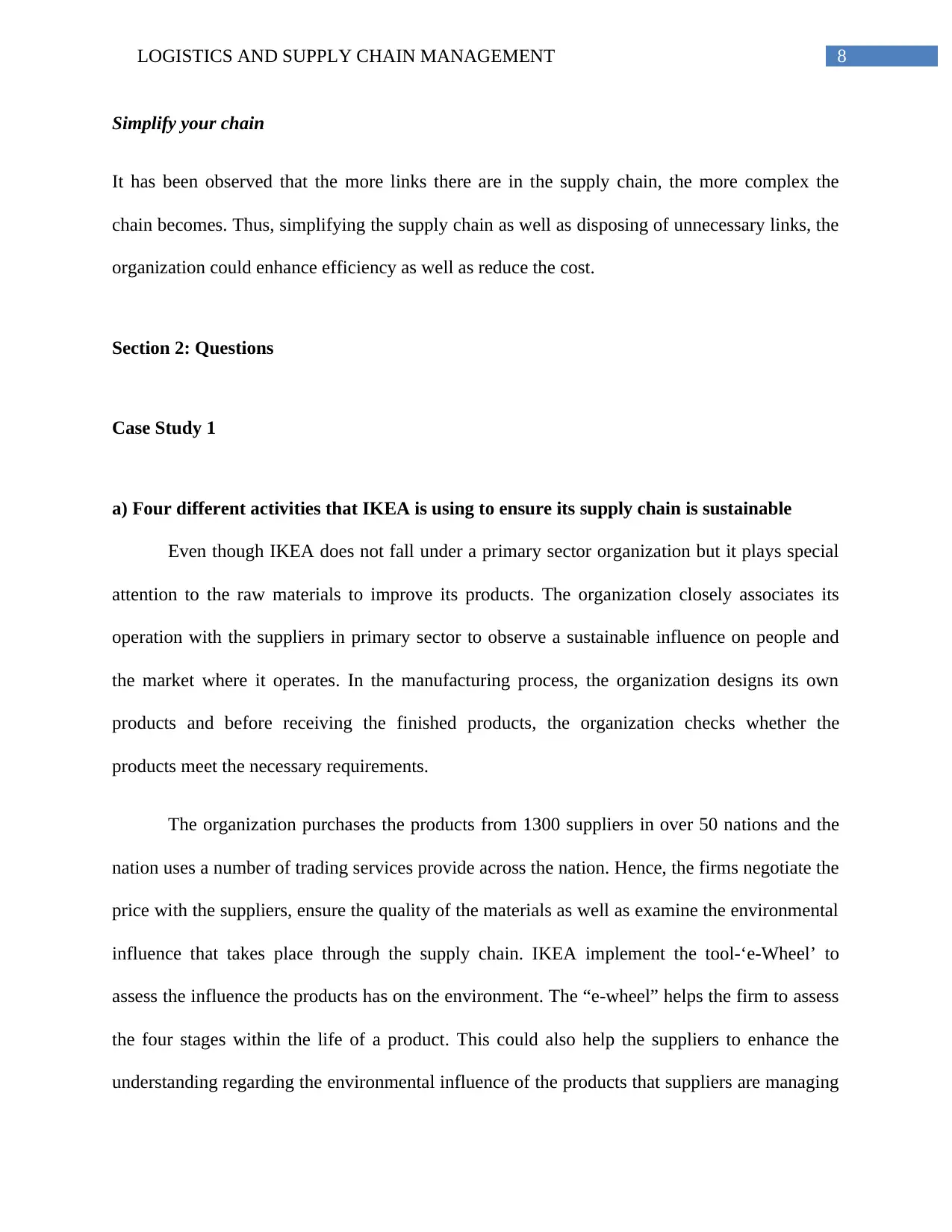
8LOGISTICS AND SUPPLY CHAIN MANAGEMENT
Simplify your chain
It has been observed that the more links there are in the supply chain, the more complex the
chain becomes. Thus, simplifying the supply chain as well as disposing of unnecessary links, the
organization could enhance efficiency as well as reduce the cost.
Section 2: Questions
Case Study 1
a) Four different activities that IKEA is using to ensure its supply chain is sustainable
Even though IKEA does not fall under a primary sector organization but it plays special
attention to the raw materials to improve its products. The organization closely associates its
operation with the suppliers in primary sector to observe a sustainable influence on people and
the market where it operates. In the manufacturing process, the organization designs its own
products and before receiving the finished products, the organization checks whether the
products meet the necessary requirements.
The organization purchases the products from 1300 suppliers in over 50 nations and the
nation uses a number of trading services provide across the nation. Hence, the firms negotiate the
price with the suppliers, ensure the quality of the materials as well as examine the environmental
influence that takes place through the supply chain. IKEA implement the tool-‘e-Wheel’ to
assess the influence the products has on the environment. The “e-wheel” helps the firm to assess
the four stages within the life of a product. This could also help the suppliers to enhance the
understanding regarding the environmental influence of the products that suppliers are managing
Simplify your chain
It has been observed that the more links there are in the supply chain, the more complex the
chain becomes. Thus, simplifying the supply chain as well as disposing of unnecessary links, the
organization could enhance efficiency as well as reduce the cost.
Section 2: Questions
Case Study 1
a) Four different activities that IKEA is using to ensure its supply chain is sustainable
Even though IKEA does not fall under a primary sector organization but it plays special
attention to the raw materials to improve its products. The organization closely associates its
operation with the suppliers in primary sector to observe a sustainable influence on people and
the market where it operates. In the manufacturing process, the organization designs its own
products and before receiving the finished products, the organization checks whether the
products meet the necessary requirements.
The organization purchases the products from 1300 suppliers in over 50 nations and the
nation uses a number of trading services provide across the nation. Hence, the firms negotiate the
price with the suppliers, ensure the quality of the materials as well as examine the environmental
influence that takes place through the supply chain. IKEA implement the tool-‘e-Wheel’ to
assess the influence the products has on the environment. The “e-wheel” helps the firm to assess
the four stages within the life of a product. This could also help the suppliers to enhance the
understanding regarding the environmental influence of the products that suppliers are managing
⊘ This is a preview!⊘
Do you want full access?
Subscribe today to unlock all pages.

Trusted by 1+ million students worldwide
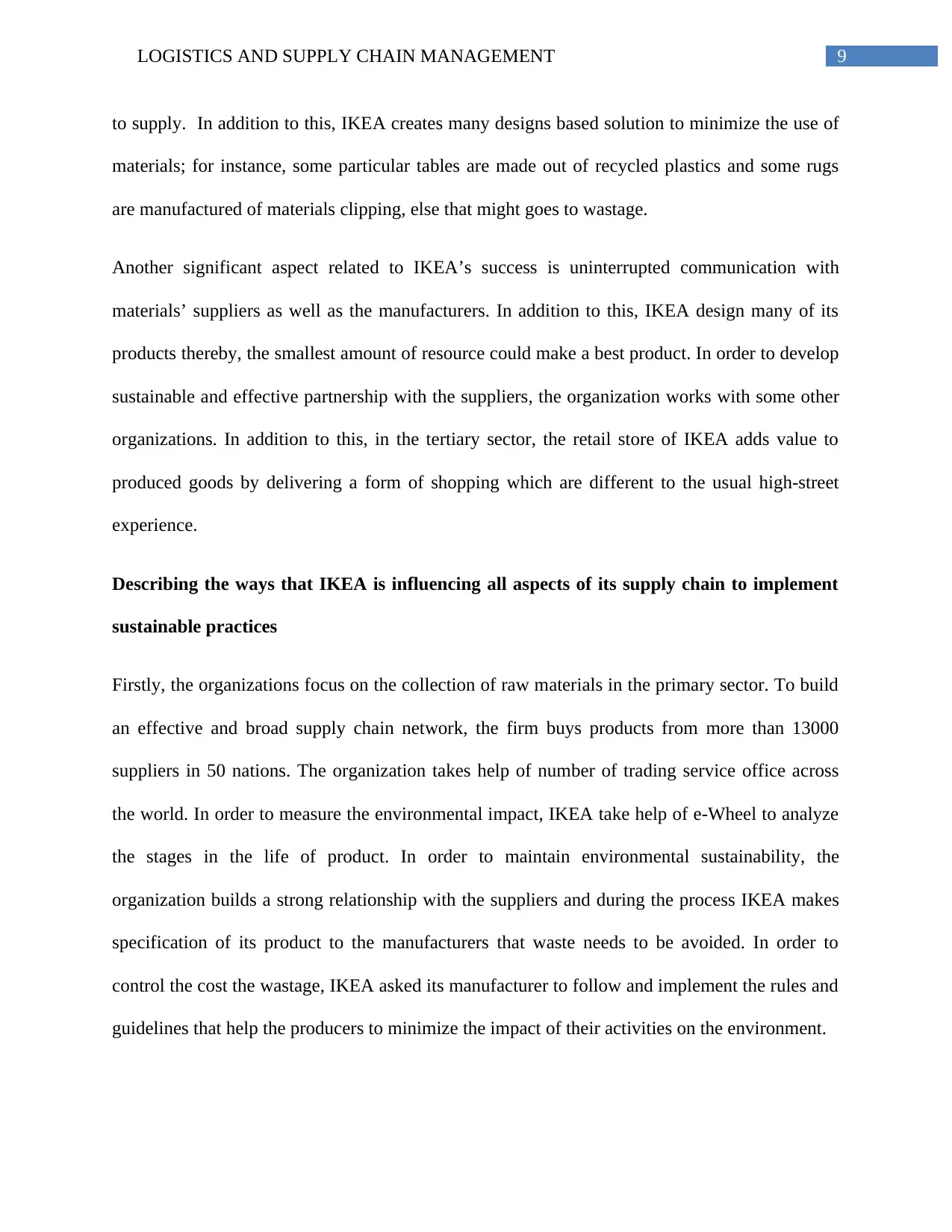
9LOGISTICS AND SUPPLY CHAIN MANAGEMENT
to supply. In addition to this, IKEA creates many designs based solution to minimize the use of
materials; for instance, some particular tables are made out of recycled plastics and some rugs
are manufactured of materials clipping, else that might goes to wastage.
Another significant aspect related to IKEA’s success is uninterrupted communication with
materials’ suppliers as well as the manufacturers. In addition to this, IKEA design many of its
products thereby, the smallest amount of resource could make a best product. In order to develop
sustainable and effective partnership with the suppliers, the organization works with some other
organizations. In addition to this, in the tertiary sector, the retail store of IKEA adds value to
produced goods by delivering a form of shopping which are different to the usual high-street
experience.
Describing the ways that IKEA is influencing all aspects of its supply chain to implement
sustainable practices
Firstly, the organizations focus on the collection of raw materials in the primary sector. To build
an effective and broad supply chain network, the firm buys products from more than 13000
suppliers in 50 nations. The organization takes help of number of trading service office across
the world. In order to measure the environmental impact, IKEA take help of e-Wheel to analyze
the stages in the life of product. In order to maintain environmental sustainability, the
organization builds a strong relationship with the suppliers and during the process IKEA makes
specification of its product to the manufacturers that waste needs to be avoided. In order to
control the cost the wastage, IKEA asked its manufacturer to follow and implement the rules and
guidelines that help the producers to minimize the impact of their activities on the environment.
to supply. In addition to this, IKEA creates many designs based solution to minimize the use of
materials; for instance, some particular tables are made out of recycled plastics and some rugs
are manufactured of materials clipping, else that might goes to wastage.
Another significant aspect related to IKEA’s success is uninterrupted communication with
materials’ suppliers as well as the manufacturers. In addition to this, IKEA design many of its
products thereby, the smallest amount of resource could make a best product. In order to develop
sustainable and effective partnership with the suppliers, the organization works with some other
organizations. In addition to this, in the tertiary sector, the retail store of IKEA adds value to
produced goods by delivering a form of shopping which are different to the usual high-street
experience.
Describing the ways that IKEA is influencing all aspects of its supply chain to implement
sustainable practices
Firstly, the organizations focus on the collection of raw materials in the primary sector. To build
an effective and broad supply chain network, the firm buys products from more than 13000
suppliers in 50 nations. The organization takes help of number of trading service office across
the world. In order to measure the environmental impact, IKEA take help of e-Wheel to analyze
the stages in the life of product. In order to maintain environmental sustainability, the
organization builds a strong relationship with the suppliers and during the process IKEA makes
specification of its product to the manufacturers that waste needs to be avoided. In order to
control the cost the wastage, IKEA asked its manufacturer to follow and implement the rules and
guidelines that help the producers to minimize the impact of their activities on the environment.
Paraphrase This Document
Need a fresh take? Get an instant paraphrase of this document with our AI Paraphraser
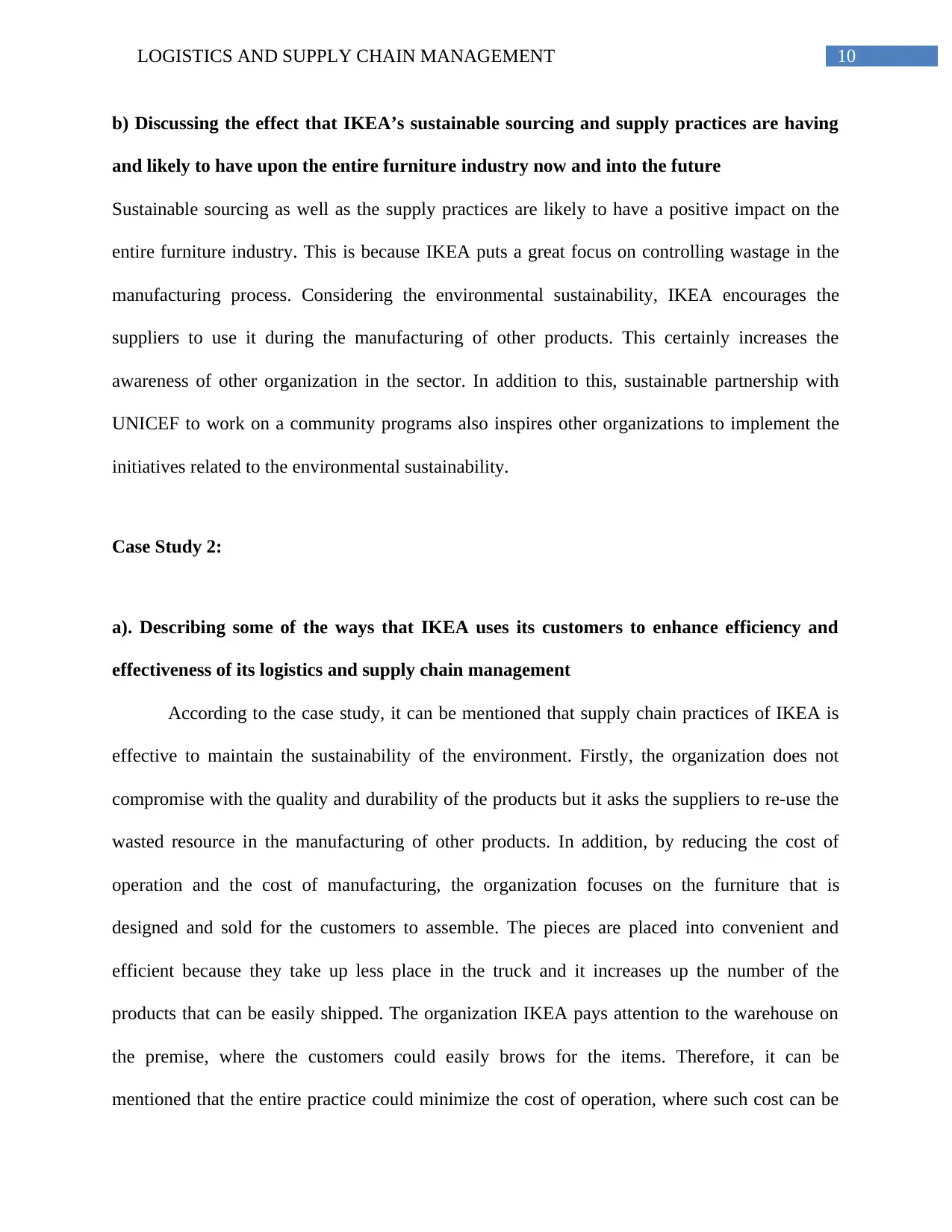
10LOGISTICS AND SUPPLY CHAIN MANAGEMENT
b) Discussing the effect that IKEA’s sustainable sourcing and supply practices are having
and likely to have upon the entire furniture industry now and into the future
Sustainable sourcing as well as the supply practices are likely to have a positive impact on the
entire furniture industry. This is because IKEA puts a great focus on controlling wastage in the
manufacturing process. Considering the environmental sustainability, IKEA encourages the
suppliers to use it during the manufacturing of other products. This certainly increases the
awareness of other organization in the sector. In addition to this, sustainable partnership with
UNICEF to work on a community programs also inspires other organizations to implement the
initiatives related to the environmental sustainability.
Case Study 2:
a). Describing some of the ways that IKEA uses its customers to enhance efficiency and
effectiveness of its logistics and supply chain management
According to the case study, it can be mentioned that supply chain practices of IKEA is
effective to maintain the sustainability of the environment. Firstly, the organization does not
compromise with the quality and durability of the products but it asks the suppliers to re-use the
wasted resource in the manufacturing of other products. In addition, by reducing the cost of
operation and the cost of manufacturing, the organization focuses on the furniture that is
designed and sold for the customers to assemble. The pieces are placed into convenient and
efficient because they take up less place in the truck and it increases up the number of the
products that can be easily shipped. The organization IKEA pays attention to the warehouse on
the premise, where the customers could easily brows for the items. Therefore, it can be
mentioned that the entire practice could minimize the cost of operation, where such cost can be
b) Discussing the effect that IKEA’s sustainable sourcing and supply practices are having
and likely to have upon the entire furniture industry now and into the future
Sustainable sourcing as well as the supply practices are likely to have a positive impact on the
entire furniture industry. This is because IKEA puts a great focus on controlling wastage in the
manufacturing process. Considering the environmental sustainability, IKEA encourages the
suppliers to use it during the manufacturing of other products. This certainly increases the
awareness of other organization in the sector. In addition to this, sustainable partnership with
UNICEF to work on a community programs also inspires other organizations to implement the
initiatives related to the environmental sustainability.
Case Study 2:
a). Describing some of the ways that IKEA uses its customers to enhance efficiency and
effectiveness of its logistics and supply chain management
According to the case study, it can be mentioned that supply chain practices of IKEA is
effective to maintain the sustainability of the environment. Firstly, the organization does not
compromise with the quality and durability of the products but it asks the suppliers to re-use the
wasted resource in the manufacturing of other products. In addition, by reducing the cost of
operation and the cost of manufacturing, the organization focuses on the furniture that is
designed and sold for the customers to assemble. The pieces are placed into convenient and
efficient because they take up less place in the truck and it increases up the number of the
products that can be easily shipped. The organization IKEA pays attention to the warehouse on
the premise, where the customers could easily brows for the items. Therefore, it can be
mentioned that the entire practice could minimize the cost of operation, where such cost can be
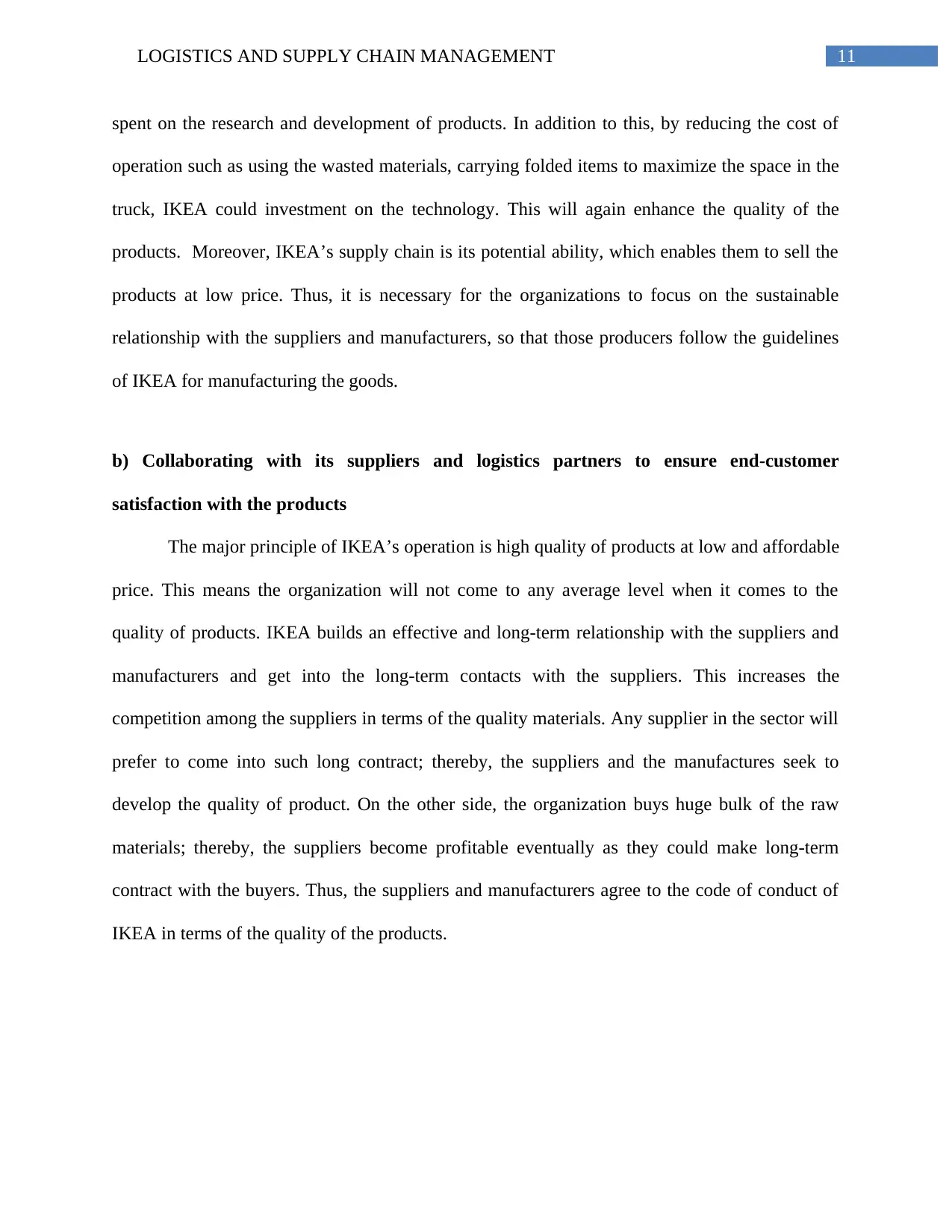
11LOGISTICS AND SUPPLY CHAIN MANAGEMENT
spent on the research and development of products. In addition to this, by reducing the cost of
operation such as using the wasted materials, carrying folded items to maximize the space in the
truck, IKEA could investment on the technology. This will again enhance the quality of the
products. Moreover, IKEA’s supply chain is its potential ability, which enables them to sell the
products at low price. Thus, it is necessary for the organizations to focus on the sustainable
relationship with the suppliers and manufacturers, so that those producers follow the guidelines
of IKEA for manufacturing the goods.
b) Collaborating with its suppliers and logistics partners to ensure end-customer
satisfaction with the products
The major principle of IKEA’s operation is high quality of products at low and affordable
price. This means the organization will not come to any average level when it comes to the
quality of products. IKEA builds an effective and long-term relationship with the suppliers and
manufacturers and get into the long-term contacts with the suppliers. This increases the
competition among the suppliers in terms of the quality materials. Any supplier in the sector will
prefer to come into such long contract; thereby, the suppliers and the manufactures seek to
develop the quality of product. On the other side, the organization buys huge bulk of the raw
materials; thereby, the suppliers become profitable eventually as they could make long-term
contract with the buyers. Thus, the suppliers and manufacturers agree to the code of conduct of
IKEA in terms of the quality of the products.
spent on the research and development of products. In addition to this, by reducing the cost of
operation such as using the wasted materials, carrying folded items to maximize the space in the
truck, IKEA could investment on the technology. This will again enhance the quality of the
products. Moreover, IKEA’s supply chain is its potential ability, which enables them to sell the
products at low price. Thus, it is necessary for the organizations to focus on the sustainable
relationship with the suppliers and manufacturers, so that those producers follow the guidelines
of IKEA for manufacturing the goods.
b) Collaborating with its suppliers and logistics partners to ensure end-customer
satisfaction with the products
The major principle of IKEA’s operation is high quality of products at low and affordable
price. This means the organization will not come to any average level when it comes to the
quality of products. IKEA builds an effective and long-term relationship with the suppliers and
manufacturers and get into the long-term contacts with the suppliers. This increases the
competition among the suppliers in terms of the quality materials. Any supplier in the sector will
prefer to come into such long contract; thereby, the suppliers and the manufactures seek to
develop the quality of product. On the other side, the organization buys huge bulk of the raw
materials; thereby, the suppliers become profitable eventually as they could make long-term
contract with the buyers. Thus, the suppliers and manufacturers agree to the code of conduct of
IKEA in terms of the quality of the products.
⊘ This is a preview!⊘
Do you want full access?
Subscribe today to unlock all pages.

Trusted by 1+ million students worldwide
1 out of 13
Related Documents
Your All-in-One AI-Powered Toolkit for Academic Success.
+13062052269
info@desklib.com
Available 24*7 on WhatsApp / Email
![[object Object]](/_next/static/media/star-bottom.7253800d.svg)
Unlock your academic potential
Copyright © 2020–2025 A2Z Services. All Rights Reserved. Developed and managed by ZUCOL.





